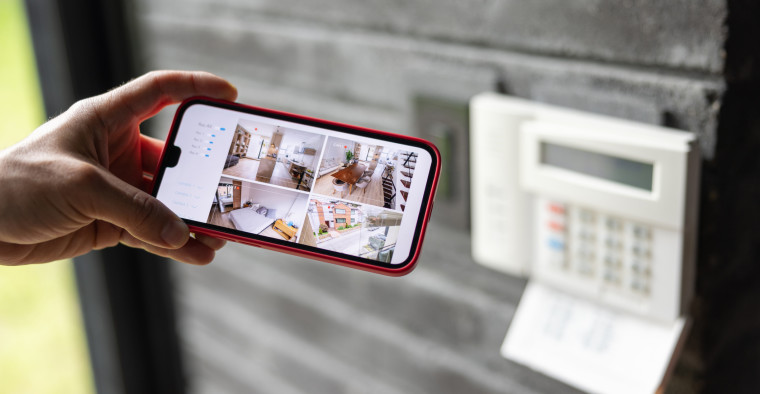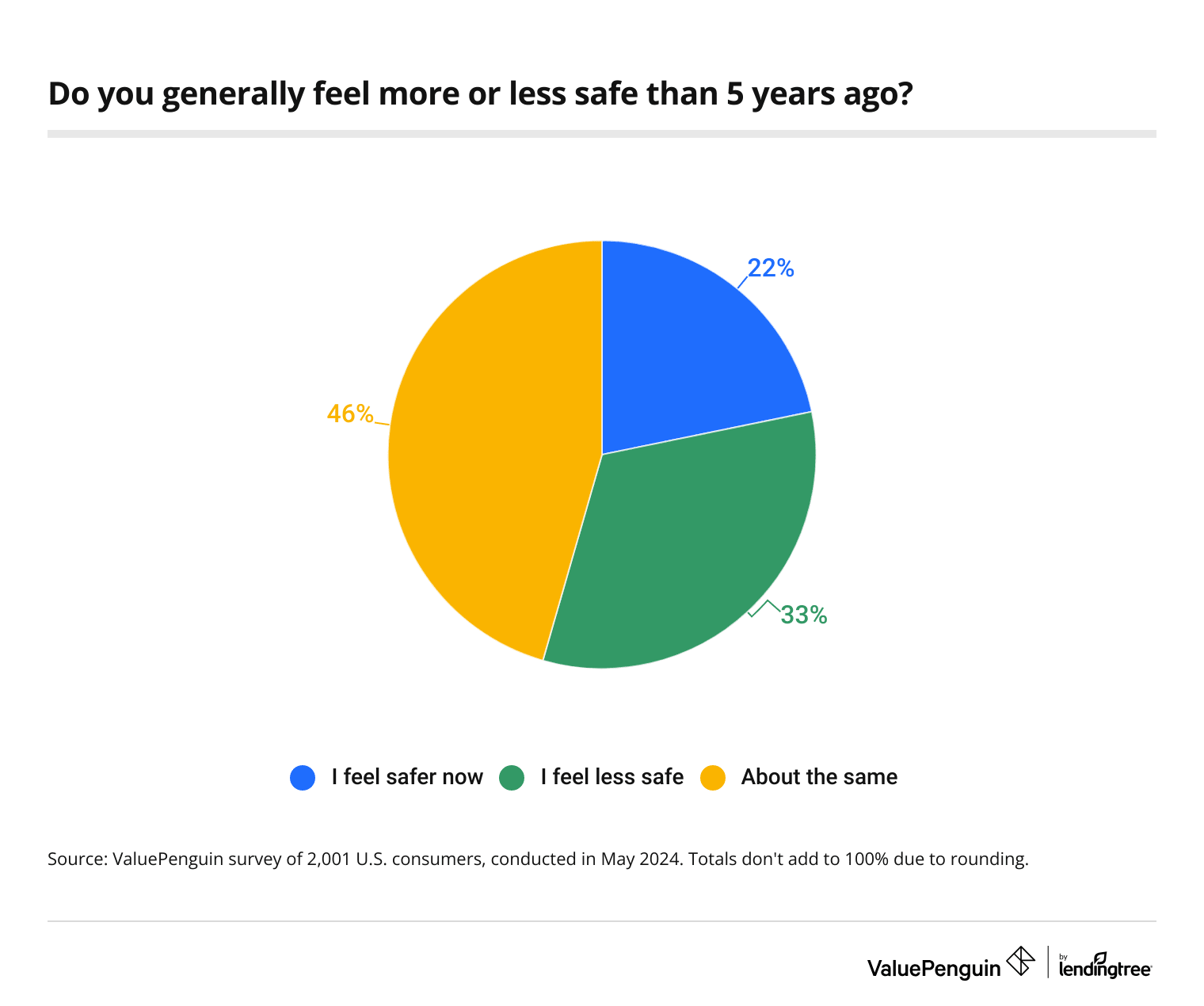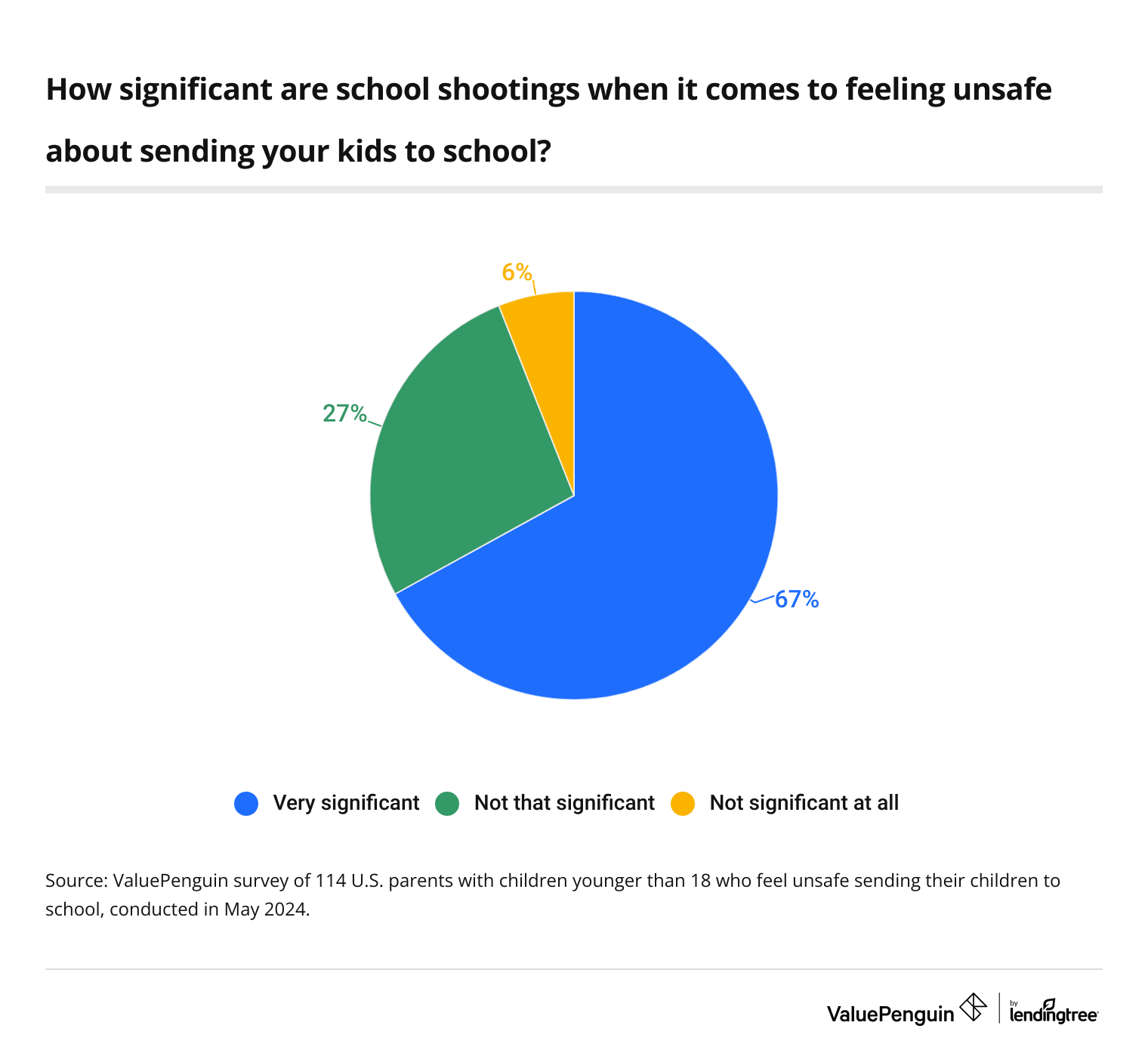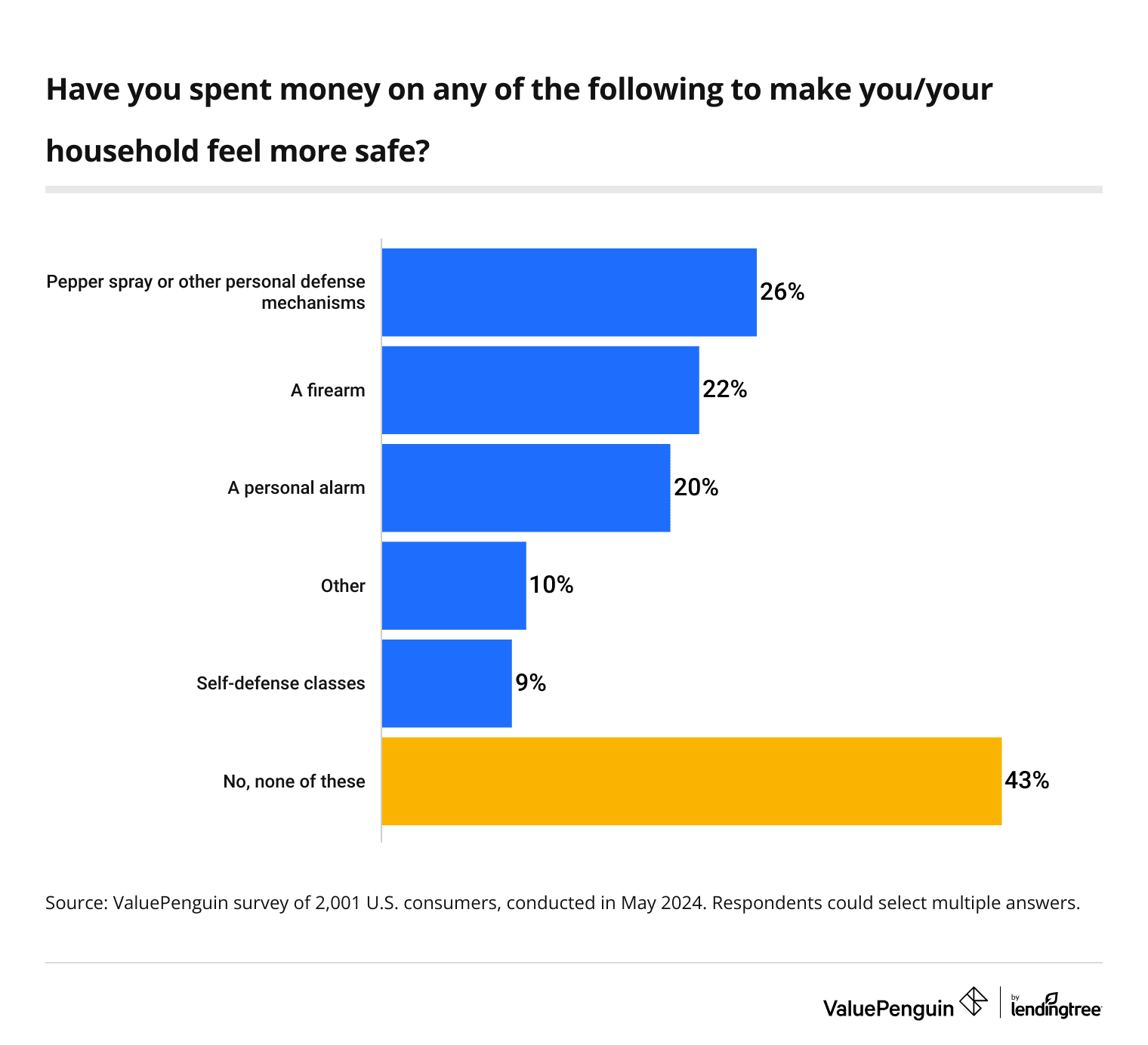Homeowners Insurance
ValuePenguin 2024 Personal Safety Report

A third of Americans feel increasingly less safe in their daily lives. According to the latest ValuePenguin survey of over 2,000 U.S. consumers, 33% feel less safe than five years ago.
Here’s a look at the crimes Americans are concerned about and what they’re doing to combat their fears. We’ll also go over tips on utilizing home insurance to improve personal safety.
On this page
Key findings
- A third (33%) of Americans feel less safe than five years ago. Meanwhile, just 22% feel safer than five years ago. When asked what crimes they most worry they’ll be a victim of, Americans said identity theft (22%), gun violence (17%) and burglary (10%).
- Women (36%) are more likely than men (29%) to feel less safe than five years ago. Overall, 71% of American women have made lifestyle changes to feel safer, including taking more precautions when alone (50%), always letting someone know where they are (30%) and avoiding certain areas (30%).
-
Even though Americans have noticed more crime in their area, most still have faith in their local law enforcement. Over half (54%) of Americans feel crime levels have risen in their area over the past five years, though 61% agree their law enforcement is effective. Faith in law enforcement varies among generations, with Gen Zers having far less confidence than baby boomers, at 50% versus 69%.
- For some parents, sending their children to school is cause for concern. 17% of parents with young kids don’t feel school is a safe place for their child, and only a third (33%) feel "very safe" about it. These concerns are largely driven by the prevalence of school shootings, with 67% admitting they contribute to their feelings of unsafeness. Social media and online news sources only fuel fear, as 69% of parents with young kids who keep up with current affairs say doing so makes them more concerned about safety. 64% of American parents with young kids say the same about social media.
- Many are taking action to calm their fears. Over half (57%) of Americans have spent money on something to better protect themselves or their household. These purchases include personal defense devices like pepper spray (26%), a firearm (22%) or a personal alarm (20%).
Americans have safety concerns
Feeling safe is crucial to one’s well-being, and many Americans feel their safety is dwindling. In fact, 1 in 3 (33%) Americans feel less safe than five years ago, while just 22% feel safer than then.

By age group, older Americans are more likely to feel more unsafe than before, with 42% of baby boomers ages 60 to 78 and 36% of Gen Xers ages 44 to 59 sharing this sentiment. Conversely, just 27% of millennials ages 28 to 43 and 25% of Gen Zers ages 18 to 27 say similarly.
According to ValuePenguin home insurance expert Divya Sangameshwar, Americans’ fears are valid. "A huge part of this perception can be pinned to increases across various crimes during the pandemic," she says. "Rising crime rates also received in-depth media coverage, which influenced how we think about our safety. Our perception of safety has also been impacted by a surge in stories on social media and from friends, family members and neighbors saying they or someone they knew was a recent victim of a crime."
Regardless of whether they feel less or more safe, 22% of Americans say they’re most concerned about being a victim of identity theft. That’s followed by:
- Gun violence (17%)
- Burglary (10%)
- Cybercrime (8%)
- Fraud (7%)
- Mugging (6%)
- Hate crime (5%)
- Sexual assault (5%)
- Assault (4%)
- Carjacking (4%)
- Murder/manslaughter (3%)
- Kidnapping (2%)
Across all demographics, baby boomers (34%) are the most likely to worry about identity theft. Meanwhile, those with children younger than 18 (20%) are the demographic most worried they’ll be a victim of gun violence. Also worth noting, 12% of Gen Zers are most worried about sexual assault — the only demographic in the double digits for this crime.
While 43% of Americans haven’t been a victim of any of the crimes mentioned, 17% have experienced burglary — the most common response. Following that, the next most common crimes are:
- Identity theft (16%)
- Fraud (11%)
- Assault (10%)
- Sexual assault (9%)
- Hate crime (7%)
- Mugging (7%)
- Cybercrime (7%)
- Gun violence (6%)
- Carjacking (3%)
- Kidnapping (1%)
- Arson (1%)
- Murder/manslaughter of someone close (1%)
Baby boomers (21%) and those with children 18 or older (20%) are the most likely to have experienced a burglary, while millennials (13%) and those with children younger than 18 (13%) are the most likely to report being victims of assault. Women (13%), those earning less than $30,000 (13%) and Gen Zers (12%) are the most likely to report being victims of sexual assault.
Women are more likely than men to feel less safe
When it comes to feeling safe, women are more likely than men to have concerns. While 29% of men feel less safe now than five years ago, that figure rises to 36% among women.
Women are also generally more likely to do something about their safety. Overall, 64% of Americans have made lifestyle changes to feel safer, a figure that rises to 71% among women. Also worth noting, those with children younger than 18 (67%) are more likely to make lifestyle changes for safety reasons than those with children 18 or older (65%) and those without children (60%).
Among women, the top lifestyle changes include taking more precautions when alone (50%), always letting someone know where they are (30%) and avoiding certain areas (30%). Meanwhile, men (9%) are more likely than women (7%) to take public transportation less — the only response where men rank higher.

According to Sangameswhar, these aren’t the only safety measures women should consider. "If you’re online, don’t check in on social media apps when you arrive somewhere or post pictures or videos live," she says. "It’s tempting to livestream from a party or vacation, but it’s safer to post photos or videos after."
It’s also important to remember that most violence against women is committed by someone they know. Women in potentially dangerous situations can seek help by:
- Dialing 911 in an emergency
- Contacting the National Domestic Violence Hotline by phone — 800-799-7233 (SAFE) — text or chat
- Visiting the U.S. Department of Health and Human Services’ Office on Women’s Health website
Women are more likely to report feeling unsafe, but men are more likely to be victims of the crimes we asked about. While 61% of men say they were a victim of one of the crimes listed, 53% of women report this.
Despite believing crime is up, Americans trust officers
There’s a reason many Americans feel less safe now — 54% believe crime levels have risen in their area over the past five years. Still, most Americans have faith in their police system, as 61% agree that their law enforcement is effective.
That confidence varies by demographic. While baby boomers (69%) have the most faith in the police system by age group, Gen Zers (50%) have the least. Meanwhile, six-figure earners (71%) are the most confident income group, and those earning less than $30,000 (52%) are the least. Men (62%) are also more likely to have faith in the police than women (59%).
Is crime rising? According to the Council on Criminal Justice, crime rates were higher in 2023 than in 2019 in seven categories. Motor vehicle theft saw the biggest increase in crime rates, at 105%. That’s followed by carjacking (93%), gun assault (32%), homicide (18%), aggravated assault (8%), nonresidential burglary (3%) and robbery (1%). Meanwhile, five categories saw a decrease in crime rates in that period, including residential burglary (26%), larceny (7%) and domestic violence (6%).
Parents with young children worry about school shootings
For some parents, sending their children to school is another factor in their fears. In fact, 17% of parents with young kids don’t feel school is a safe place for their child, while only 33% feel school is "very safe."
School shootings may play a role. Of the parents who feel unsafe, 67% say shootings are a very significant factor in their feelings of unsafety.

Of course, social media and online news sometimes help fuel the fear factor. Of parents with young kids who keep up with the news, 69% say doing so makes them more concerned about safety. Meanwhile, 64% of all American parents with young kids say the same about social media.
Across Americans who keep up with the news, 63% say it contributes to their safety concerns. Meanwhile, 53% of Americans (regardless of their news consumption) say social media does.
Americans are investing in personal safety
With these safety concerns in mind, it’s understandable that 57% of Americans have spent money on something to better protect themselves or their household. That figure’s high among Gen Zers (68%), millennials (62%) and men (59%).
Across Americans, 26% bought pepper spray — the most common response. A firearm (22%) and a personal alarm (20%) were the next most common personal safety purchases.

Despite the many debates around gun ownership and safety, 52% of Americans say they feel safer if they or someone they're with has a gun.
If you plan to purchase a personal protection device like a gun or taser, Sangameshwar says it’s important that you learn how to properly store and use these devices and to get the appropriate licenses and permissions to own them. "If you have young children at home, keep these devices locked and secured," she says. "You should also check your homeowners or renters insurance policy to see the level of protection you have."
Most homeowners and renters insurance policies typically cover theft and accidental or unintentional damage caused by these devices. However, some insurers will require you to purchase additional coverage for them or increase your liability coverage in case anyone injured by your personal protection devices chooses to sue.
While Americans are buying some personal defense items and classes, they aren’t spending money on other protective measures. In fact, the majority (85%) of Americans haven’t gotten more insurance coverage to protect them financially if they’re victims of a crime, while 84% haven’t sought help from a therapist to address their safety concerns and their impact on their mental health.
Top 3 safety tips
Extra protection may be worth the peace of mind, particularly for those worried about crime. Sangameshwar recommends the following:
- Invest in home protection technology. Installing dead bolts, fire prevention systems, smart locks, motion detectors, burglar alarms and security video cameras will make your homes safer and keep intruders away. Installing these safety devices also comes with homeowners insurance discounts of up to 10% depending on the insurer.
- Maintain a low profile online, and be careful with your personal data. "Never share Social Security numbers, PINs or any other data linked to your identity or your family members’ identities," she says. "Don’t put credit card numbers in emails or texts. Avoid opening emails from people you don't know, and never click on links or attachments unless you’re sure they’re legitimate. Stay away from online quizzes asking for facts about your personal life events and preferences, and look into your insurance coverage for protections."
- While insurance companies can’t prevent identity theft, they can help with the financial losses you may encounter from it. "Most insurers (renters and home) offer identity theft coverage as an add-on and will reimburse you for costs like notary fees, bank fees, lost wages, legal fees, child care costs and help with other services like identity restoration," she says. "In fact, some insurers are already offering this as part of a standard policy. Employers are also offering ID theft protection as a benefit, and you can also buy a stand-alone policy from insurers like LifeLock and IDShield."
Methodology
LendingTree commissioned QuestionPro to conduct an online survey of 2,001 U.S. consumers ages 18 to 78 from May 1 to 2, 2024. The survey was administered using a nonprobability-based sample, and quotas were used to ensure the sample base represented the overall population. Researchers reviewed all responses for quality control.
We defined generations as the following ages in 2024:
- Generation Z: 18 to 27
- Millennial: 28 to 43
- Generation X: 44 to 59
- Baby boomer: 60 to 78